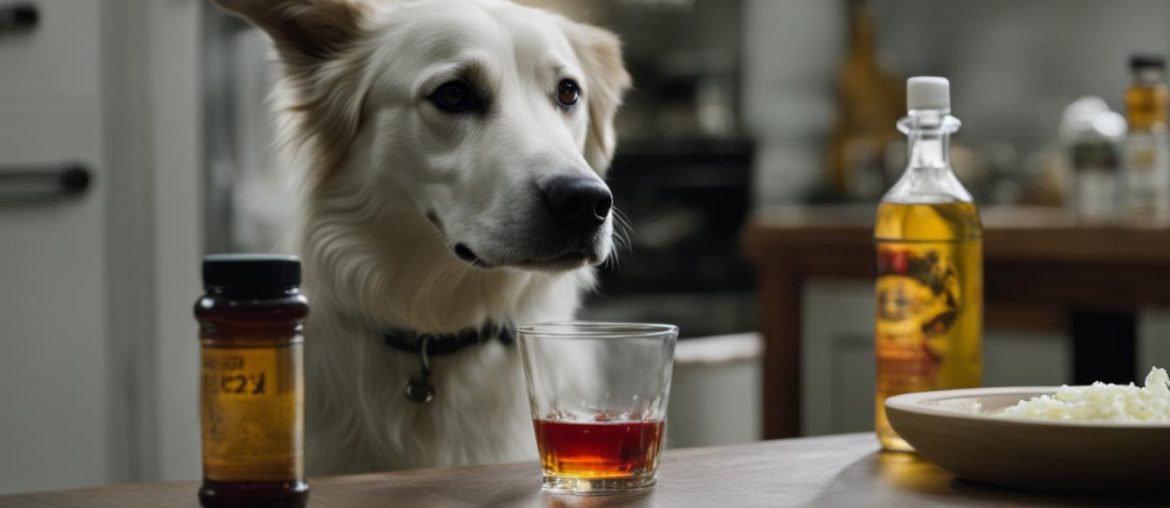Dogs have a highly developed sense of smell and can detect even small traces of their own scent. Vinegar, specifically white vinegar, can be used as a deterrent to prevent dogs from peeing in the same spot. It is the acetic acid in vinegar that dogs dislike and find repulsive. Vinegar is non-toxic, inexpensive, and eco-friendly, making it a popular choice for deterring dogs from peeing in certain areas. However, vinegar should not be used on organic surfaces like grass or plants, as it can damage them. It may be necessary to reapply vinegar regularly to reinforce the deterrent effect.
Key Takeaways:
- Vinegar can be used to deter dogs from peeing in the same spot.
- The acetic acid in vinegar is what dogs find repulsive.
- Vinegar is non-toxic, inexpensive, and eco-friendly.
- Avoid using vinegar on grass or plants as it may cause damage.
- Regular reapplication of vinegar may be necessary for effective deterrence.
How to Use Vinegar to Stop Dog Peeing in Same Spot
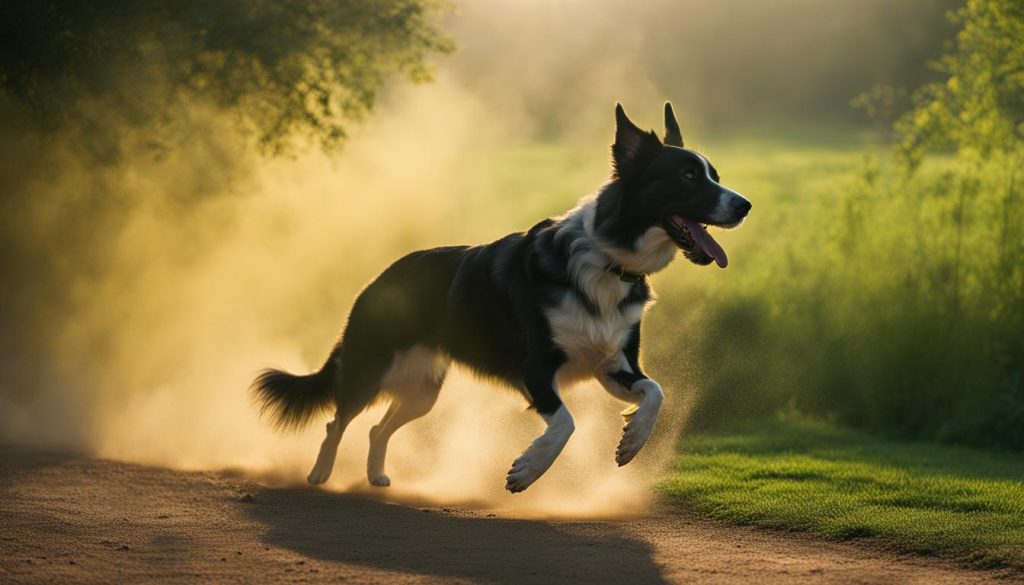
To effectively use vinegar as a natural dog pee repellent, you can create a vinegar solution by mixing equal parts white vinegar and water in a spray bottle. This solution can be applied to the areas where your dog has been urinating. The strong smell of vinegar will discourage your dog from returning to those spots. However, the smell of vinegar will linger in your home for a while, so it may take some time to adjust.
In cases where your dog’s peeing habit is persistent, you can use undiluted vinegar to intensify the smell and increase its effectiveness as a deterrent. Simply spray the undiluted vinegar directly onto the affected areas. It’s worth mentioning that vinegar should not be used on organic surfaces such as grass or plants, as it can cause damage.
Regularly reapplying the vinegar solution is necessary, especially after rain or if the area gets washed out. This will help reinforce the deterrent effect and discourage your dog from peeing in the same spot again.
The importance of consistency
Consistency is key when using vinegar as a dog pee deterrent. Dogs thrive on routine, so it’s crucial to remain consistent in applying the vinegar solution and reinforcing the idea that certain areas are off-limits for peeing. Over time, with consistent use of vinegar and proper training techniques, your dog will learn where it is appropriate to eliminate and will be less likely to pee in unwanted spots.
Using vinegar as a natural dog pee repellent can be an effective and eco-friendly solution. However, it’s important to remember that every dog is unique, and what works for one may not work for another. If your dog’s peeing habit persists despite using vinegar, it may be beneficial to consult a professional dog trainer or veterinarian for additional guidance.
Pros and Cons of Using Vinegar as a Dog Pee Deterrent
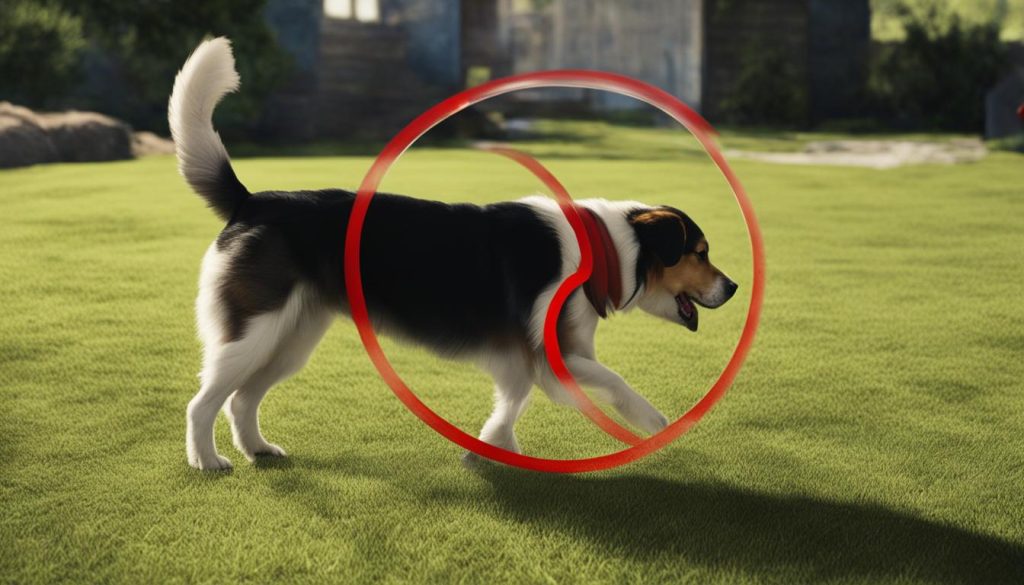
Using vinegar as a dog pee deterrent has both advantages and disadvantages. Let’s take a look at the pros and cons of using vinegar to prevent dogs from urinating in the same place.
Pros of Using Vinegar:
- Vinegar is a non-toxic and safe option for pets and children. Unlike some commercial repellents that may contain harmful chemicals, vinegar is a natural and eco-friendly choice.
- It is an inexpensive alternative to commercial products. Vinegar is readily available in most households, making it a cost-effective dog pee deterrent.
- Vinegar breaks down quickly in the environment, minimizing its impact on the ecosystem. This makes it a sustainable option for those who prioritize eco-friendly solutions.
- Compared to other commercial repellents, vinegar has a milder smell that is less harsh and chemical-like. This can be more pleasant for pet owners and their families.
Cons of Using Vinegar:
- Vinegar can damage organic surfaces such as grass or plants if used in high concentrations. It is important to avoid applying vinegar directly to these areas to prevent any harm.
- The strong smell of vinegar may linger in your home for a while. While it can be effective in deterring dogs from peeing, it may take some time to adjust to the scent.
When considering using vinegar as a dog pee deterrent, it is crucial to weigh these pros and cons and make an informed decision based on your specific circumstances. Remember to use vinegar responsibly and in a manner that prioritizes the safety of both your pets and the environment.
| Pros of Using Vinegar | Cons of Using Vinegar |
|---|---|
| Vinegar is non-toxic and safe for pets and children. | Vinegar can damage organic surfaces such as grass or plants. |
| It is an inexpensive alternative to commercial products. | The strong smell of vinegar may linger in your home for a while. |
| Vinegar is eco-friendly and breaks down quickly in the environment. | |
| Vinegar has a milder smell compared to other commercial repellents. |
Dogs Dislike Strong Odors: Using Odors to Deter Dogs from Peeing in the Same Spot
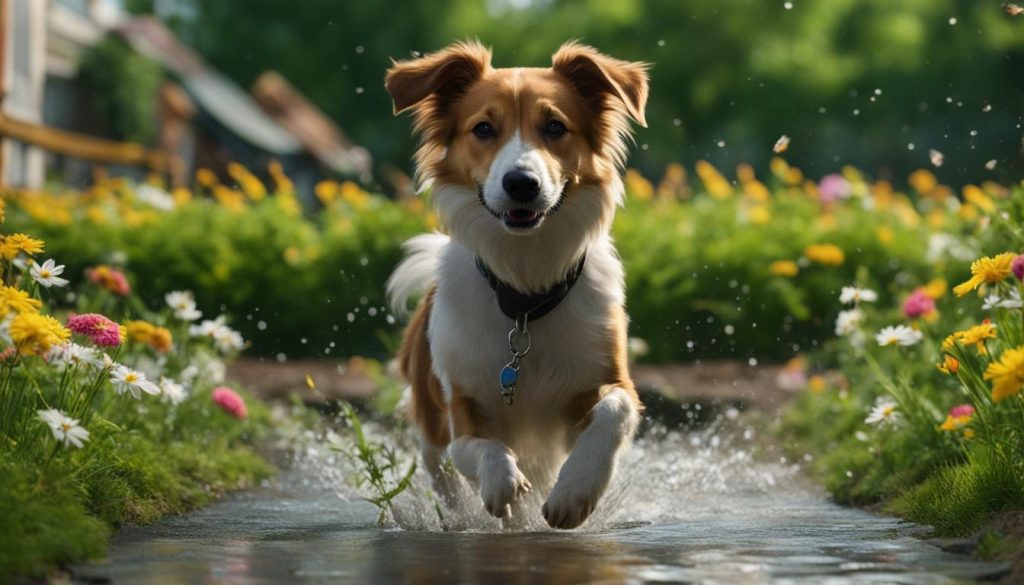
When it comes to deterring dogs from peeing in certain areas, using odors that dogs dislike can be an effective method. Dogs have a highly developed sense of smell, and certain scents can be repulsive to them. Citrus scent, such as that of lemons or oranges, is one odor that dogs find unpleasant and can deter them from peeing in specific spots. Spicy peppers, like jalapenos, are another scent that dogs dislike due to their sensitive noses. Ammonia is also known to be repulsive to dogs and can be used as a deterrent.
Incorporating these odors into your dog deterrence strategy can be as simple as placing citrus rinds in the areas where your dog tends to pee or using citrus-scented essential oils. For peppers, you can create a spray by grinding the peppers and mixing them with water. Ammonia can be diluted with water and sprayed in the desired areas. It is important to note that while these odors can be effective, they should be used in moderation and with caution to ensure the safety of your dog and the environment.
“By utilizing odors that dogs dislike, we can create an environment that discourages them from peeing in the same spot.”
It is worth mentioning that each dog is unique, and what may work as a deterrent for one dog may not work for another. It may require some trial and error to discover which odors are most effective in deterring your particular dog. Additionally, it is important to incorporate other training methods and proper potty training techniques to reinforce the desired behavior of eliminating in appropriate areas.
Table: Comparison of Odors that Dogs Dislike
| Odor | Method of Application | Effectiveness |
|---|---|---|
| Citrus | Placing citrus rinds or using citrus-scented essential oils in the desired areas | Moderate effectiveness; may vary depending on the dog |
| Spicy Peppers | Creating a spray by grinding peppers and mixing with water | Moderate effectiveness; may vary depending on the dog |
| Ammonia | Diluting ammonia with water and spraying in the desired areas | Effective for most dogs, but use with caution |
Using odors that dogs dislike can be a natural and eco-friendly way to deter dogs from peeing in the same spot. By utilizing odors that dogs find repulsive, we can create an environment that discourages them from returning to those areas. However, it is important to remember that consistency and patience are key when implementing any deterrent method, and it may take time to achieve the desired results.
Using Citrus, Peppers, and Ammonia to Deter Dogs from Peeing
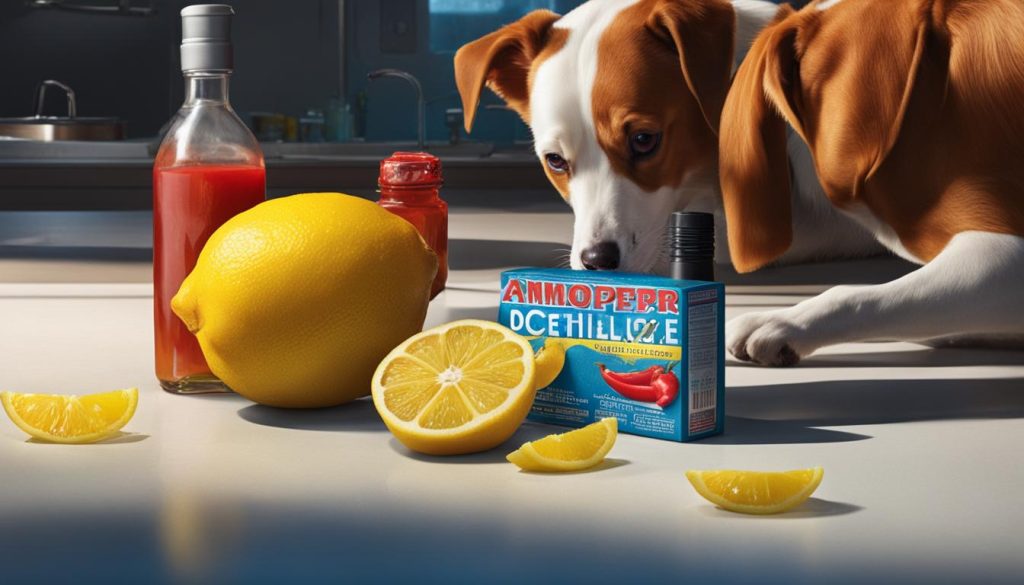
When it comes to deterring dogs from peeing in unwanted areas, there are several natural options besides vinegar. Citrus, peppers, and ammonia are all strong odors that dogs dislike and can be used as effective deterrents.
Using Citrus
Citrus fruits, such as lemons and oranges, have a strong scent that dogs find repulsive. To use citrus as a dog deterrent, you can place citrus rinds or use citrus-scented essential oils in the areas where your dog tends to pee. The smell of citrus will discourage your dog from returning to those spots. However, some dogs may be attracted to the smell of citrus, so it may not work for every dog.
Using Peppers
Spicy peppers, like jalapenos, can also be effective in deterring dogs from peeing in certain areas. Dogs have sensitive noses, and the strong scent of peppers can be overwhelming for them. To use peppers as a dog repellent, you can grind them into a paste and mix it with water to create a spray. Apply the spray to the desired areas where your dog has been peeing. The strong scent will discourage your dog from going back to those spots. However, it’s important to use peppers in moderation and avoid using them in areas where they could be harmful to other animals or children.
Using Ammonia
Ammonia is another odor that dogs find repulsive and can be used as a deterrent. To use ammonia to discourage dogs from peeing in certain spots, dilute it with water and spray it in the desired areas. The strong scent of ammonia will deter dogs from using those spots as their bathroom. However, it’s important to use ammonia in moderation and avoid using it in areas where it could be harmful to plants or animals.
Overall, using citrus, peppers, and ammonia can be effective natural deterrents to prevent dogs from peeing in unwanted areas. However, it’s important to consider the preferences and sensitivities of your specific dog before relying solely on these methods. Additionally, it’s crucial to use these odors responsibly and avoid any potential harm to other animals, plants, or children.
Commercial Odor Eliminators for Dog Pee

When it comes to preventing dogs from peeing in the same spot, using commercial odor eliminators can be an effective solution. These products are specifically designed to eliminate the odor of dog urine, rather than just masking it. Enzymatic cleaners, in particular, are highly recommended as they contain enzymes that break down the molecules responsible for the unpleasant smell.
Choosing the right odor eliminator is essential for achieving optimal results. When considering different options, it is important to take into account the type of surface you are treating, whether it is carpet, upholstery, or a hard floor. Some products may be formulated for specific surfaces, ensuring effective stain and odor removal without causing any damage.
Additionally, look for odor eliminators that are safe to use around pets and children. This is particularly important to ensure the well-being of your furry friend and prevent any potential harm. Reading product labels and reviews can provide valuable insights into the safety and effectiveness of commercial odor eliminators.
Training Your Dog to Avoid Peeing in the House
Dogs are intelligent animals that can be trained to follow basic commands and behaviors, including where to eliminate. Proper potty training is crucial for preventing accidents in the house and ensuring that your dog understands where it is appropriate to pee. By using positive reinforcement techniques and establishing a consistent routine, you can effectively train your dog to avoid peeing in the house.
“Consistency and patience are key when potty training a dog, and accidents should be handled calmly and without punishment.”
To start potty training your dog, designate a specific area in your yard or outside where you want your dog to pee. Take your dog to this spot regularly, especially after meals, naps, or playtime, and encourage them to eliminate there. Use verbal cues or commands, such as “go potty” or “do your business,” to associate the action with the designated spot. When your dog successfully eliminates in the right spot, reward them with praise and treats to reinforce the desired behavior.
If your dog has an accident in the house, it is important not to punish or scold them. Dogs do not understand punishment after the fact, and it can create fear or anxiety. Instead, clean up the mess using an enzymatic cleaner to eliminate the odor and prevent your dog from recognizing it as a potential elimination spot. Continue with the potty training routine, being consistent and patient with your dog as they learn and adjust to the desired behavior.
| Key Tips for Dog Potty Training |
|---|
| Establish a designated area outside for your dog to eliminate. |
| Take your dog to the designated spot regularly, especially after meals and playtime. |
| Use verbal cues or commands to associate the designated area with the action of peeing. |
| Reward your dog with praise and treats when they eliminate in the right spot. |
| Do not punish or scold your dog for accidents in the house. |
| Clean up accidents with enzymatic cleaner to eliminate odors. |
| Be consistent and patient with your dog as they learn and adjust to the routine. |
Remember, every dog is unique and may require different approaches to potty training. Some dogs may learn quickly, while others may take longer to fully grasp the concept. It is important to remain patient, understanding, and consistent throughout the training process. With time and positive reinforcement, your dog will learn to avoid peeing in the house and to eliminate in the designated area.
Housebreaking a Dog: Common Challenges and Solutions
- Problem: Accidents in the house even after potty training. Solution: Revisit the potty training routine and reinforce positive reinforcement techniques. Consider consulting a professional dog trainer for further guidance.
- Problem: Overexcitement or anxiety leading to accidents. Solution: Ensure regular exercise and mental stimulation to help calm your dog. Create a relaxing environment and provide appropriate outlets for energy.
- Problem: Marking behavior or territory marking. Solution: Neuter or spay your dog to reduce hormonal influences. Clean and neutralize previously marked areas to prevent reoccurrence.
- Problem: Submissive urination. Solution: Avoid intimidating or dominating behaviors. Use positive reinforcement and build your dog’s confidence through training and socialization.
By understanding the principles of dog potty training and implementing consistent and positive reinforcement techniques, you can effectively train your dog to avoid peeing in the house. Remember to be patient, celebrate successes, and adjust your approach as needed. With time and dedication, you and your dog can establish a harmonious environment where accidents are minimized, and the desired behavior is reinforced.
Eco-Friendly DIY Tips for Dog Pee Prevention
When it comes to deterring dogs from peeing in unwanted areas, there are several eco-friendly DIY methods that can be effective alternatives to commercial products. These natural deterrents are not only safer for the environment but also easy to implement at home. Here are some eco-friendly DIY tips for preventing dog pee in unwanted spots.
1. Vinegar Spray
Vinegar, specifically white vinegar, can be used as a natural dog pee deterrent. Mix equal parts white vinegar and water in a spray bottle and apply it to the areas where your dog tends to pee. The strong smell of vinegar will discourage your dog from returning to those spots. Remember to avoid using vinegar on organic surfaces like grass or plants, as it can damage them.
2. Citronella Oil
Citronella oil has a strong scent that dogs find repulsive. You can create a citronella spray by diluting a few drops of citronella essential oil in water and spraying it in the desired areas. Citronella oil can be an effective natural deterrent for preventing dogs from peeing in specific spots.
3. Cayenne Pepper
Cayenne pepper is another natural ingredient that can be used to deter dogs from peeing in unwanted areas. Sprinkle a generous amount of cayenne pepper or chili powder on the ground where your dog tends to pee. The strong smell of the pepper will discourage your dog from using those spots.
These eco-friendly DIY tips provide natural, safe, and cost-effective methods for preventing dog pee in unwanted areas. Remember to use these deterrents responsibly and consider the specific needs and sensitivities of your dog.
| Method | Pros | Cons |
|---|---|---|
| Vinegar Spray | – Non-toxic and safe for pets and children – Inexpensive and readily available – Eco-friendly |
– Can damage organic surfaces – Strong smell may be unpleasant |
| Citronella Oil | – Dogs find the scent repulsive – Natural and safe |
– Citronella oil can be hazardous in large amounts – May need regular reapplication |
| Cayenne Pepper | – Strong smell deters dogs – Easy to apply |
– Can be messy – May need frequent reapplication |
Using Angry Orange Pet Deodorizer and Stain Remover
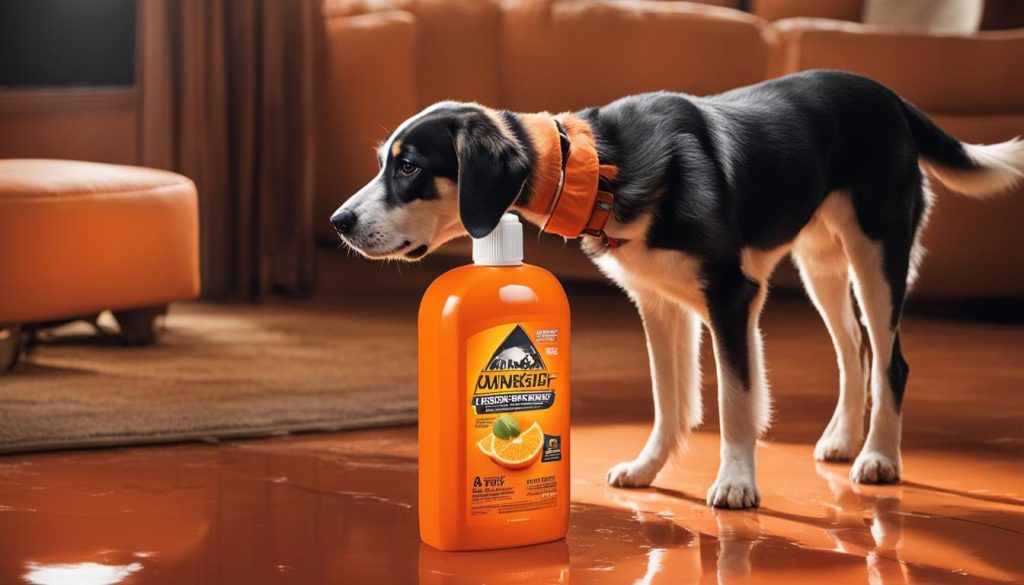
When it comes to removing pet odors and stains, one effective and reliable solution is Angry Orange Pet Deodorizer and Stain Remover. This enzyme-based cleaner is specifically designed to target and eliminate pet urine odors, providing you with a fresh and clean environment.
Angry Orange works by breaking down the molecules that cause the unpleasant smell of pet urine, rather than simply masking it. Its powerful enzymes penetrate deep into the affected area, completely removing the odor and leaving behind a refreshing citrus scent. Whether you’re dealing with old or new stains, Angry Orange can effectively tackle the problem.
What sets Angry Orange apart is its safety. It is formulated to be safe for use around children and pets, so you can have peace of mind while using it. This makes it a perfect choice for households with furry friends. With Angry Orange, you can finally say goodbye to persistent pet urine odors and stains.
So why settle for unpleasant pet odors and stains when you can rely on Angry Orange Pet Deodorizer and Stain Remover? Give it a try and experience the difference it can make in your home. Say goodbye to lingering pet odors and hello to a fresh and clean living space with the power of Angry Orange.
Eco-Friendly DIY Tips for Dog Pee Prevention
When it comes to preventing dogs from peeing in unwanted areas, there are several eco-friendly DIY tips that you can try. These methods are not only safe for the environment but also effective in deterring dogs from marking their territory. Here are some natural methods for deterring dog pee:
- Use a vinegar spray: Create a mixture of vinegar and water in a spray bottle and apply it to the areas where your dog tends to pee. The strong smell of vinegar will discourage your dog from using those spots.
- Try citronella oil: Citronella oil has a strong scent that dogs dislike. Spray it in the desired areas to deter your dog from peeing there.
- Use cayenne pepper or chili powder: Sprinkle cayenne pepper or chili powder on the ground to deter dogs from peeing in specific locations. The strong smell and taste will discourage them from using those spots.
- Use diluted ammonia: Dilute ammonia with water and spray it in the areas where your dog has been peeing. The smell of ammonia will deter your dog from using those spots.
It is important to use these methods responsibly and consider the safety of your dog and the environment. Avoid using excessive amounts of any substance and monitor your dog’s behavior closely. These DIY tips can be effective in preventing dog pee in unwanted areas while keeping your home and surroundings eco-friendly.
Why Choose Eco-Friendly Methods?
Using eco-friendly methods for dog pee prevention has several benefits. First and foremost, it helps to minimize your ecological footprint by avoiding the use of harmful chemicals and toxins. This is not only better for the environment but also safer for your pets and family members.
Additionally, eco-friendly methods are usually cost-effective and readily available. You can easily find natural ingredients like vinegar, citronella oil, and cayenne pepper at your local grocery store or online. By opting for these methods, you can save money and avoid spending on expensive commercial repellents.
Furthermore, eco-friendly methods are often versatile and multipurpose. For example, vinegar can be used for various cleaning purposes in addition to deterring dog pee. This makes it a practical and efficient option for dog owners looking for natural and sustainable solutions.
Summary
Preventing dogs from peeing in unwanted areas can be achieved through eco-friendly DIY methods. Using a vinegar spray, citronella oil, cayenne pepper, and ammonia can effectively deter dogs from marking their territory. These methods are safe, cost-effective, and easily accessible, making them a practical choice for dog owners. By embracing eco-friendly solutions, you can create a pet-friendly environment while minimizing your impact on the planet.
Wrapping Up
In conclusion, vinegar can be a valuable tool in deterring dogs from peeing in the same spot. Its acetic acid content creates a smell that dogs find repulsive, making them less likely to return to the area. However, it is essential to consider other natural deterrents and proper training methods to achieve the desired results.
Training your dog to eliminate in the designated area of your yard or outside is crucial for preventing accidents in the house. Positive reinforcement methods, such as rewards and praise, can be effective in teaching your dog where to pee. Consistency and patience are key in potty training a dog, and accidents should be handled calmly without punishment.
While using vinegar, it’s important to use eco-friendly methods and products. Enzyme-based cleaners, such as Angry Orange Pet Deodorizer and Stain Remover, are effective in eliminating pet odors and preventing dogs from peeing in the same spot. Consider the safety of any DIY methods and use them responsibly.
In summary, vinegar can be a safe and effective way to prevent dogs from peeing in unwanted spots. However, it is just one piece of the puzzle. By combining vinegar with proper training techniques, eco-friendly deterrents, and patience, you can successfully break the habit of dogs peeing in the same spot.
FAQ
Will vinegar stop a dog from peeing in the same spot?
Yes, vinegar can be used as a deterrent to prevent dogs from peeing in the same spot. The acetic acid in vinegar is repulsive to dogs and can discourage them from returning to that area. However, vinegar should not be used on organic surfaces like grass or plants as it can damage them.
How do I use vinegar to stop my dog from peeing in the same spot?
To use vinegar as a dog pee deterrent, mix equal parts white vinegar and water in a spray bottle. Thoroughly spray the affected area where your dog has been peeing. The strong smell of vinegar will discourage your dog from going back to that spot. For persistent cases, undiluted vinegar can be used to make the smell even stronger. Regular application may be necessary, especially after rain or if the area gets washed out.
What are the pros and cons of using vinegar as a dog pee deterrent?
The advantages of using vinegar as a dog pee deterrent include its non-toxic nature, affordability, and eco-friendly properties. Vinegar is safe for pets and children, unlike some commercial repellents. It breaks down quickly in the environment and has a less harsh smell compared to other repellents. However, vinegar can kill plants if used in high concentrations and the smell may linger in your home.
Are there other odors that dogs dislike?
Yes, dogs also dislike citrus scents, spicy peppers, and ammonia. These odors can be used as deterrents to prevent dogs from peeing in unwanted areas.
How can I use citrus, peppers, and ammonia to deter dogs from peeing?
Citrus rinds or citrus-scented essential oils can be placed in the desired areas to deter dogs from peeing. Peppers can be ground into a paste and mixed with water to create a spray. Ammonia can be diluted with water and sprayed in the desired areas. However, caution should be used to ensure these odors are not harmful to dogs or the environment.
What are some commercial odor eliminators for dog pee?
Enzymatic cleaners are particularly effective at eliminating pet odors, including urine. They break down the molecules that cause the odor instead of just masking it. When choosing an odor eliminator, consider the type of odor and choose a product that is safe for pets and children.
How can I train my dog to avoid peeing in the house?
Proper potty training is crucial for preventing dogs from peeing in the house. Positive reinforcement methods, consistency, and patience are key. Reward and praise your dog for peeing in the designated area and handle accidents calmly without punishment.
Are there other natural deterrents for dog pee?
Yes, coffee grounds can be sprinkled in the garden to deter dogs from peeing or digging. Baking soda can be used to remove odors and discourage dogs from using the same spot. However, it is important to consider the potential harm to plants or animals when using these natural deterrents.
What is Angry Orange Pet Deodorizer and Stain Remover?
Angry Orange is an enzyme-based cleaner specifically designed to eliminate pet odors, including urine. It breaks down the molecules that cause the odor and can be sprayed on the affected surface. It is safe to use around children and pets and leaves a refreshing citrus scent.
Are there eco-friendly DIY tips for dog pee prevention?
Yes, you can create a vinegar spray by mixing vinegar and water, use citrus-scented essential oils, sprinkle cayenne pepper or chili powder, or dilute ammonia and spray in desired areas. It is important to use these methods responsibly and consider their safety for dogs and the environment.


